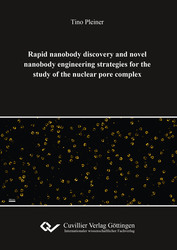| Departments | |
|---|---|
| Book Series (96) |
1378
|
| Nachhaltigkeit |
3
|
| Gesundheitswesen |
1
|
| Humanities |
2364
|
| Natural Sciences |
5406
|
| Mathematics | 229 |
| Informatics | 319 |
| Physics | 980 |
| Chemistry | 1363 |
| Geosciences | 131 |
| Human medicine | 243 |
| Stomatology | 10 |
| Veterinary medicine | 108 |
| Pharmacy | 147 |
| Biology | 835 |
| Biochemistry, molecular biology, gene technology | 121 |
| Biophysics | 25 |
| Domestic and nutritional science | 45 |
| Agricultural science | 1004 |
| Forest science | 201 |
| Horticultural science | 20 |
| Environmental research, ecology and landscape conservation | 148 |
| Engineering |
1793
|
| Common |
98
|
|
Leitlinien Unfallchirurgie
5. Auflage bestellen |
|
Advanced Search
Rapid nanobody discovery and novel nanobody engineering strategies for the study of the nuclear pore complex (English shop)
Tino Pleiner (Author)Preview
Table of Contents, PDF (84 KB)
Extract, PDF (440 KB)
Nanobodies are recombinant single-domain antibodies of camelid origin. We set out to generate nanobodies as tools to study nuclear pore complexes (NPCs) that constitute the major passageways for nucleocytoplasmic exchange. Therefore, we developed an optimized phage display-based workflow for the generation of nanobodies from an immunized animal. The identified nanobodies were functionally expressed in the E. coli cytoplasm in a disulfide bond-free form, thus overcoming the engineering limitations imposed by conventional periplasmic secretion. Using protease-cleavable affinity tags, we developed a generic strategy for native protein complex isolation from eukaryotic sources, e.g. for structural analyses by electron microscopy. We further established a reliable fluorescent labeling strategy of nanobodies that is based on engineered surface cysteines and maleimide chemistry. In contrast to NHS labeling of lysines, maleimide labeling is site-specific, does not interfere with antigen recognition and yields superior imaging reagents, especially for super-resolution microscopy. Using our optimized workflow, we obtained a large toolbox of nanobodies against constituents of Xenopus NPCs that can now be used to study various unresolved aspects of NPC structure, assembly and function.
| ISBN-13 (Hard Copy) | 9783736995154 |
| ISBN-13 (eBook) | 9783736985155 |
| Final Book Format | A5 |
| Language | English |
| Page Number | 154 |
| Lamination of Cover | glossy |
| Edition | 1. Aufl. |
| Publication Place | Göttingen |
| Place of Dissertation | Göttingen |
| Publication Date | 2017-04-03 |
| General Categorization | Dissertation |
| Departments |
Biochemistry, molecular biology, gene technology
|
| Keywords | Phage Display, Antibody engineering, Nanobody, Single domain antibody, Nuclear pore complex, NPC, Nucleocytoplasmic transport, Xenopus laevis |








